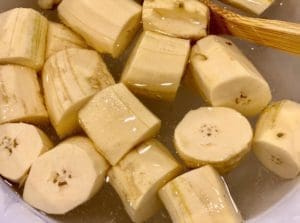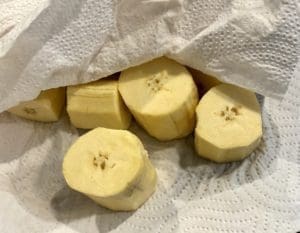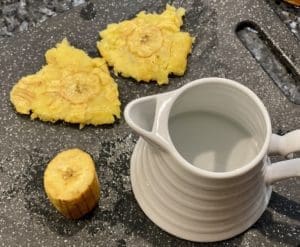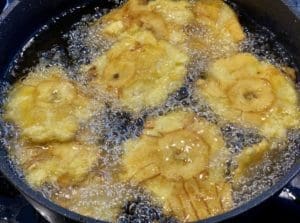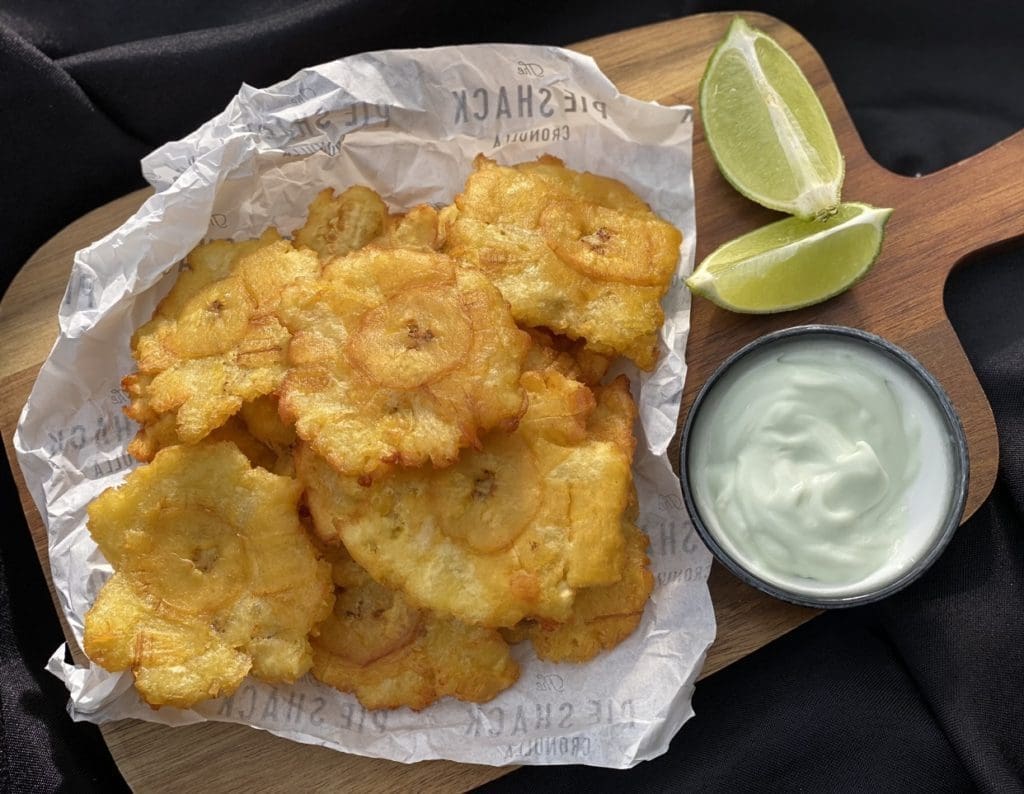
Tostones are addictive (twice) fried green plantains. A tasty snack or side dish that’s popular throughout Latin America and the Caribbean
We found plantains!
My 2-year-old, Kai and I were doing our shopping together. Lately, he insists we grab a trolley before we go into the store. So you know what that means? If I just need to pick up a loaf of bread, I’ll still be wheeling a trolley. Otherwise, someone would hit the ground wailing. I need someone to explain to me why toddlers are so temperamental.
The good thing is that Kai also insists on sitting in the trolley compartment. This means there’s no running through aisles and throwing random stuff on the ground. Instead, my little man was sitting in the trolley naming the fruits and veggies we went by.
Then out of nowhere, Kai screamed out ‘big green nanas’. I looked over and there they were. The sign read ‘Cooking bananas (plantain)’. I couldn’t believe my luck! This may sound weird depending on where you are in the world, but finding plantains at our local green grocer is rare!

Out of excitement, I grabbed a bunch and didn’t even pay attention to the price. They could’ve been $100 a kilo, but thankfully they weren’t. We paid approximately $8 for 3 large plantains. Is this expensive? I wouldn’t know! It’s rare to see plantains where I am.
When we got home, I plonked the plantains on my kitchen table. I already had in my head that I was going to turn them into tostones.
Tostones are popular in Latin America and the Caribbean. They’re fried crispy plantain eaten as a snack, starter or side dish, but they’re usually served like chips and dip. They’re fun to make and they look like pretty golden sunflowers!
There’s no batter or coating, just 100% twice-fried plantain, so you only need 3 ingredients. Green Plantain is starchy and tastes very similar to potatoes, but they’re more nutritious. That means we don’t have to feel too guilty when indulging in them!
How to pick plantains for Tostones

For making perfect savoury, thin and crispy tostones, you’ll need rock-hard unripe green plantains.
I made tostones 4 times in the space of 2 weeks! I wanted to experiment with how the tostones turned out when using semi-ripe and unripe plantain.
Unripe plantains are green and feel very solid. Even when squeezing them with some pressure, they shouldn’t give in. Semi-ripe plantain is still green looking with some yellow patches. If you squeeze it with a little pressure, it will give in slightly.
For the first batch, I didn’t soak any of the plantains in salt water as suggested by many recipes. The idea of a saltwater bath is to draw moisture from the plantain, so they will result in crispier tostones.
The semi-ripe tostones were much harder to work with because they became very soft after the first fry. When flattening them, they broke and most of them didn’t hold their shape. They also puffed up during the last fry and soaked up too much oil, making them ultra greasy.
The semi-ripe tostones had an interesting and pleasant flavour of mild banana and waxy potato. These tostones would be ideal for serving as a dessert with sweet dipping sauce. I would love to use these plantains in another sweet dish, just not as tostones.
On the second batch, I soaked the plantains in salted water for 30 minutes. It didn’t make any difference to the semi-ripe ones, as they were still soggy in the middle and only crispy on the edges. However, it made the unripe plantain crisper, so it’s worth doing this step for savoury crisp tostones.
The unripe plantain held its shape beautifully when flattened and fried. They were beautifully crispy but still a little too greasy for my liking. To get rid of the excess oil, I placed them on a cooling rack for a few minutes with baking paper underneath to catch any grease.
These plantains are starchy and tasted very similar to the potato scallops (thinly sliced potato cakes). They made perfect savoury tostones that would go amazing with many savoury dips or as a side dish.
How to serve Tostones
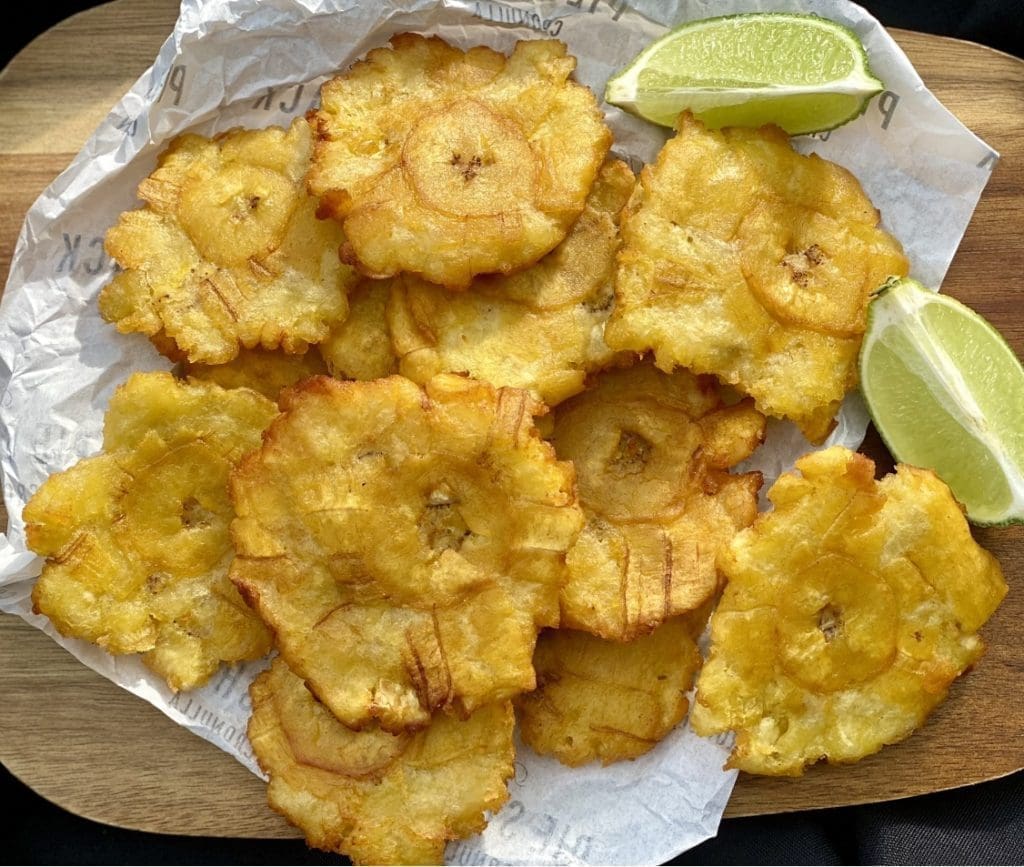
For semi-ripe or ripe tostones serve them with a simple dusting of icing sugar, chocolate dip, salted caramel, or condensed milk.
For savoury unripe tostones serve them on their own with a sprinkle of salt. They would also go amazing as a side dish along with your favourite protein. The most popular way to serve tostones is like ‘chips and dip’ with the tostones being the chips. For the dip, anything savoury would work, such as pesto, Salsa verde, Aji Verde or Cheese sauce.
Are plantains healthy?
Calorie-wise, 1 cup (150gm/5oz) of sliced and boiled plantain contains approximately 180 calories. Plantain contains more calories than potatoes and eating bananas because they’re starchier.
However, in saying that, Plantains are more nutritious than potatoes as they contain more vitamins and minerals such as potassium, magnesium and vitamins C, and B6. Looks like we could all do with more plantains in our diet!
Have a weakness for fried stuff? So do we!

Chunky Apple Fritters

Spicy Korean Chicken Wings

Karaage Fried Chicken
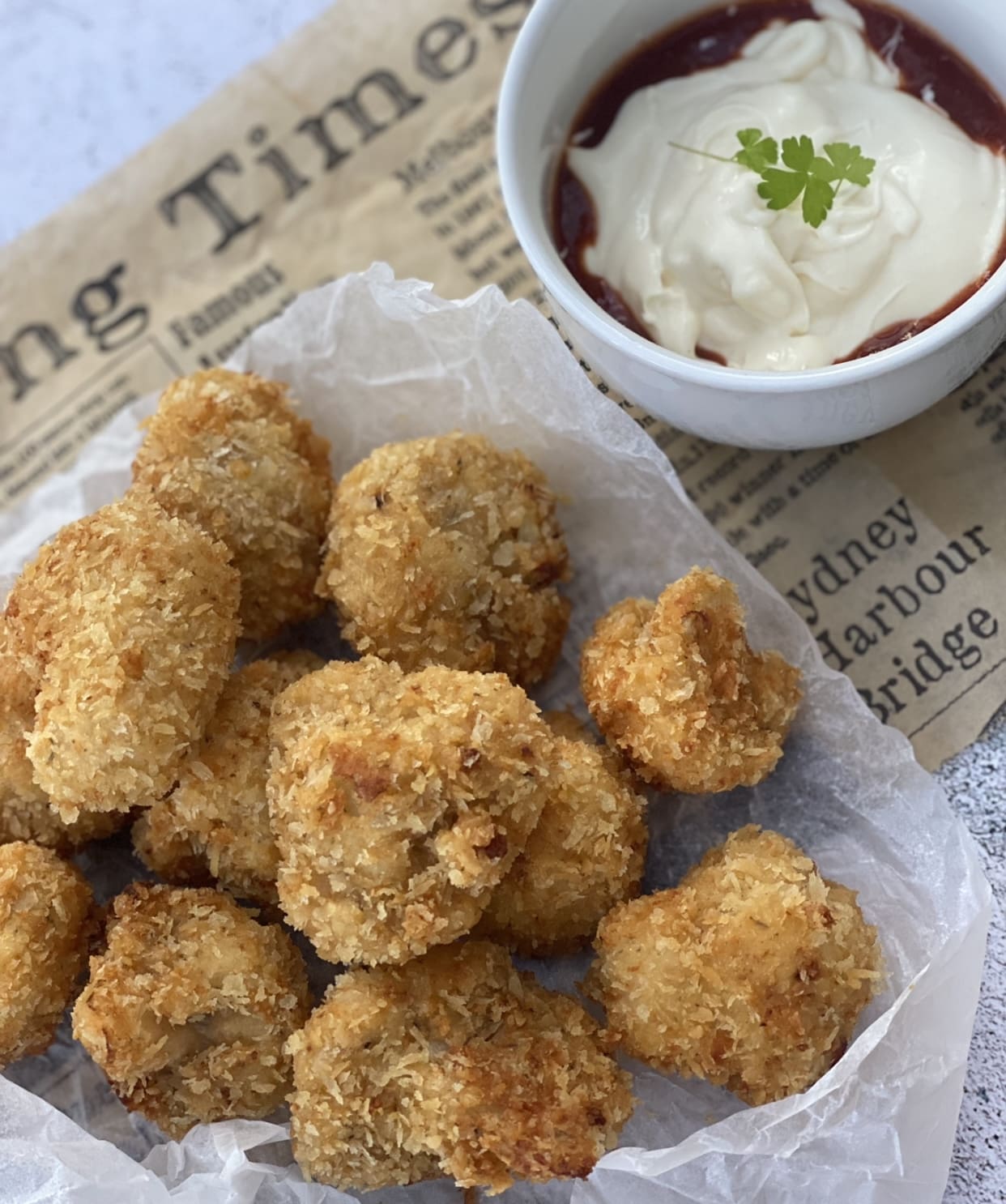
Deep Fried Cauliflower
Ingredients for Tostones
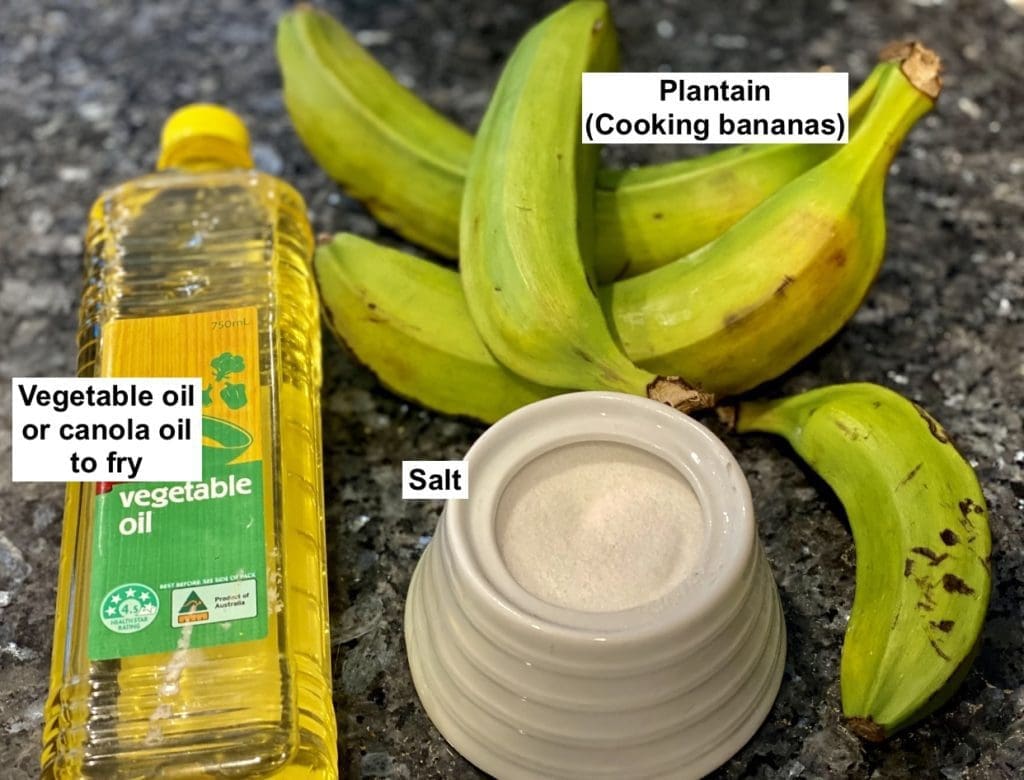
Plantains (cooking bananas) – For making perfect savoury, thin and crispy tostones, you’ll need rock-hard, unripe green plantains.
Frying oil – I used vegetable oil, but any neutral-tasting oil with a high smoke point (it doesn’t burn at high temperatures) would work. Rice bran, sunflower or corn oil are great choices for deep frying.
Salt will flavour the tostones and draw out moisture from the plantains, making the tostones more crispy after frying.
Subscribe to 3CatsFoodie’s FREE Newsletter

For the latest recipes and other fun stuff!
How to make Tostones
Step-by-step guide with photos

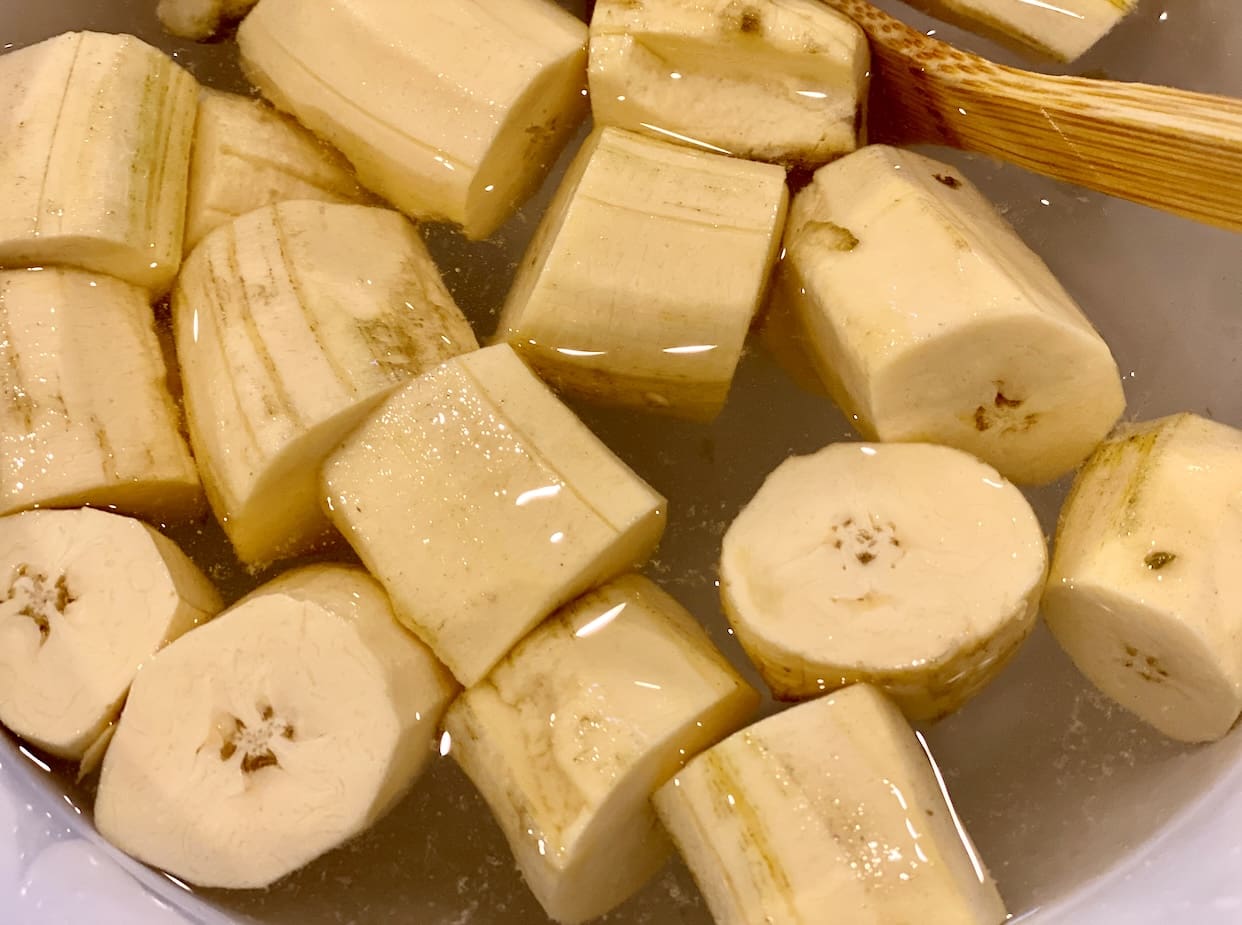
Remove the peel by slicing a small amount from the base and top of the plantain, then use a small sharp knife to make an incision through the skin lengthwise. You should be able to pry the peel from the flesh. If the plantain is very green, you may have trouble separating the skin as I did. I had to resort to shaving the peel off by using a vegetable peeler. Cut the plantain approximately into 1-inch pieces.
Fill a large bowl half full with water and stir in the salt until it dissolves. Place the plantains into the salted water for at least 30 minutes or up to 2 hours at room temperature.
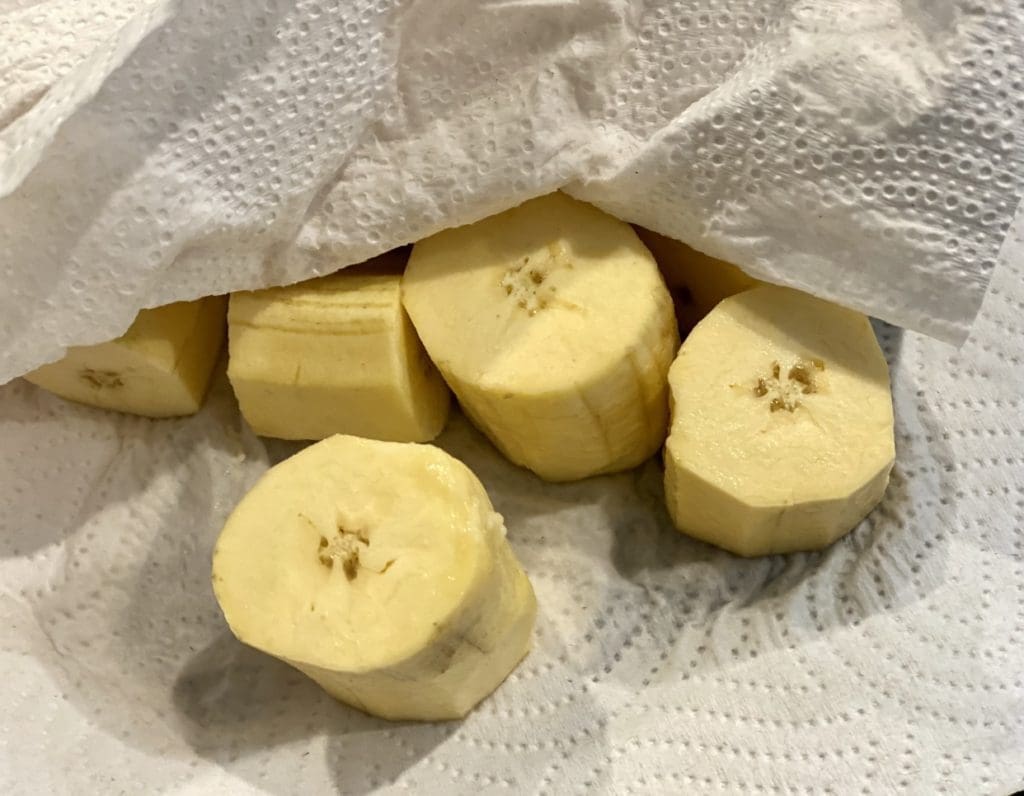
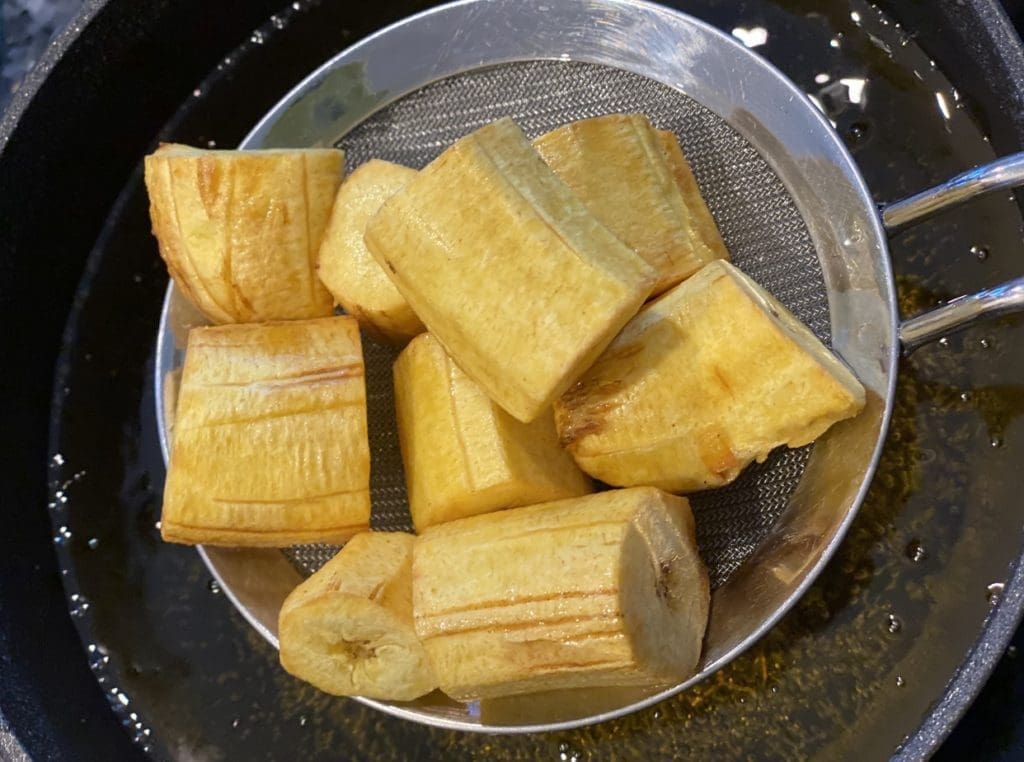
Pour enough oil into a medium heavy-based saucepan to submerge the plantains. Heat the oil over medium-high heat until it reaches 180°C (360°F). You could also test if the oil is ready by placing a wooden object into the oil (chopstick, skewer or wooden spoon). The oil is ready for frying when bubbles form around the object.
Whilst the oil is heating, remove the plantains from the salted water and dry each piece with paper towels. This part is important because the oil will dangerously spit if there’s any water left on the plantains.
Fry the plantain in small batches for 3 minutes. You may need to adjust the heat if the oil gets too hot or drops in temperature. Remove plantains from the oil and transfer them onto a plate to cool for 5 minutes. Leave the oil heated, as we will need it for our second fry.
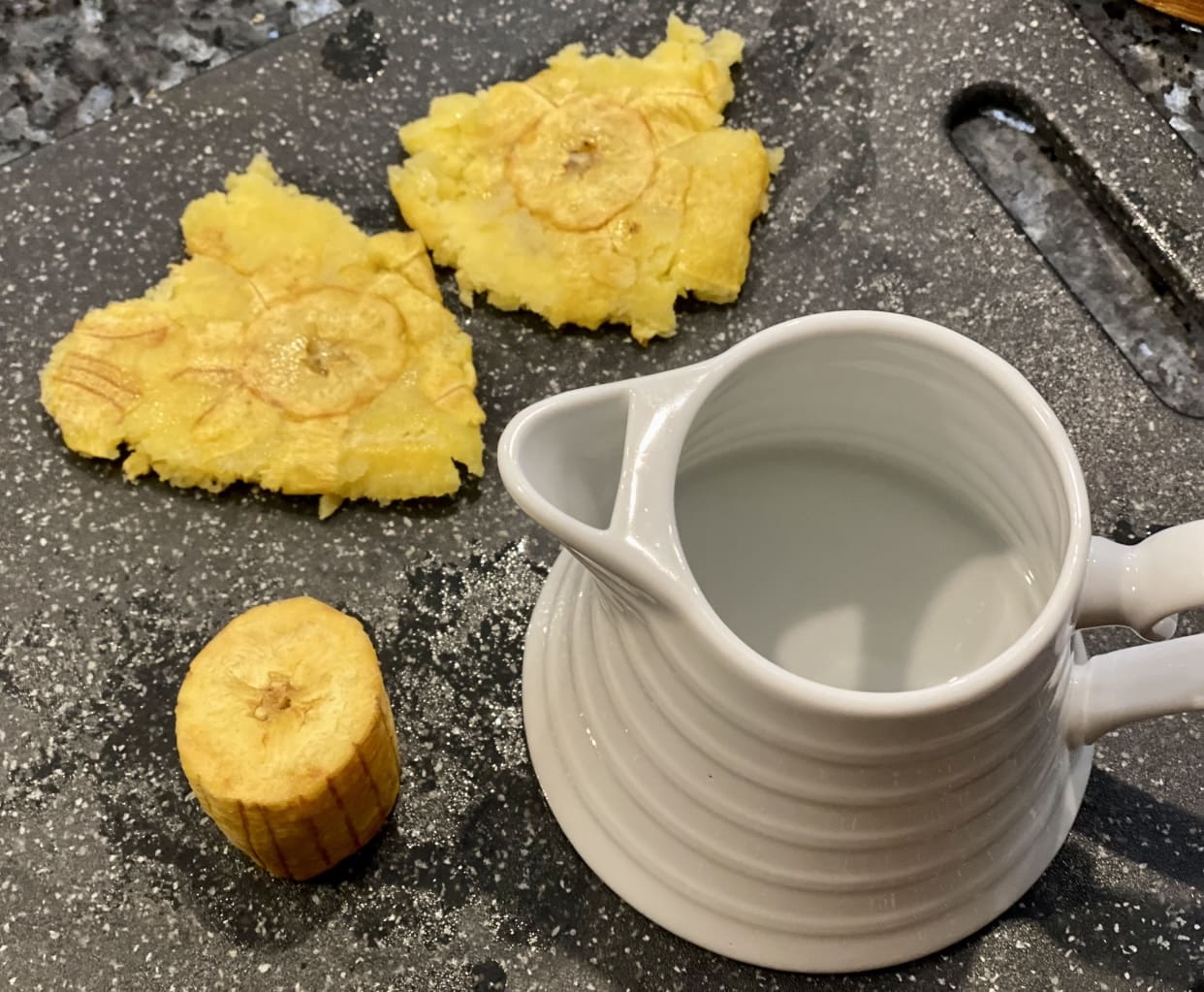
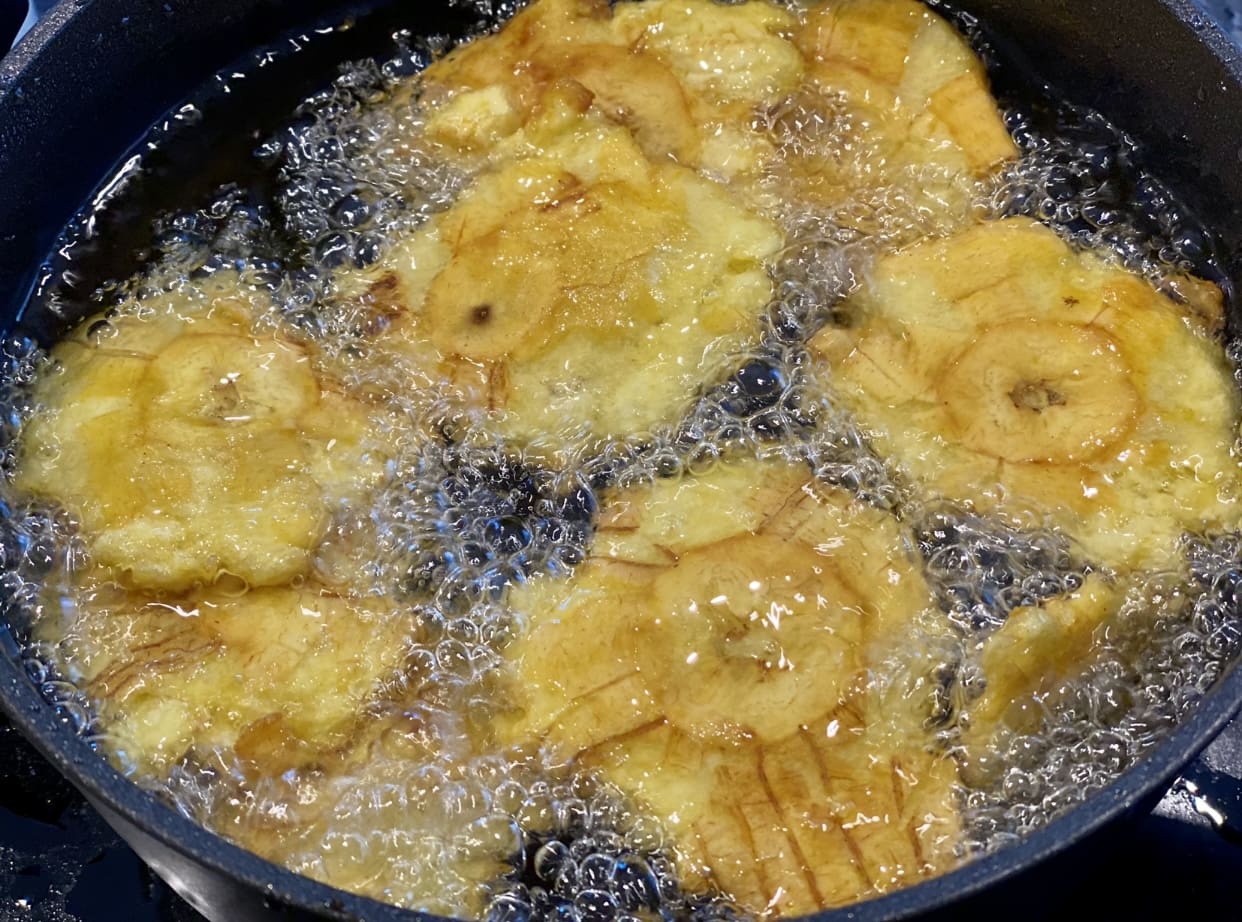
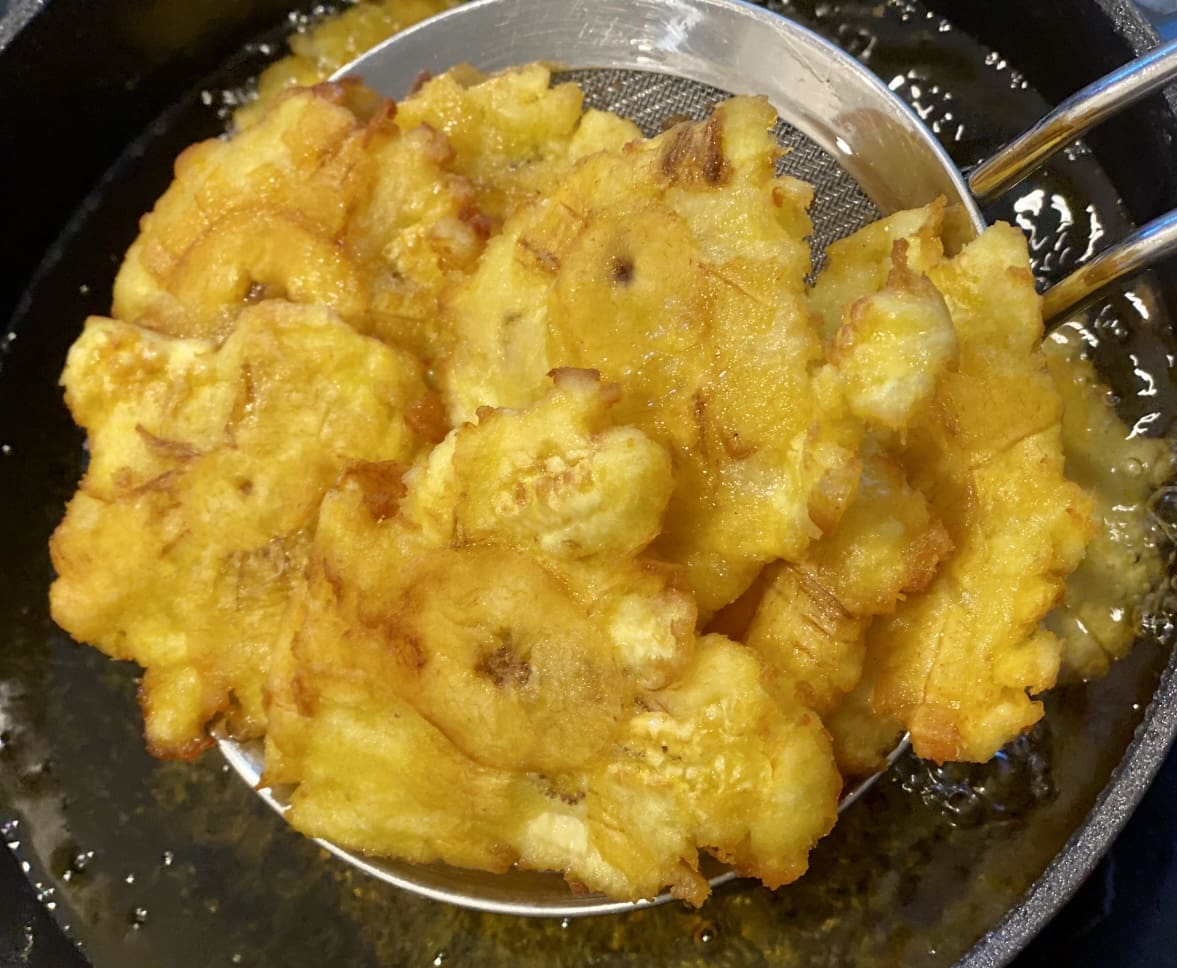
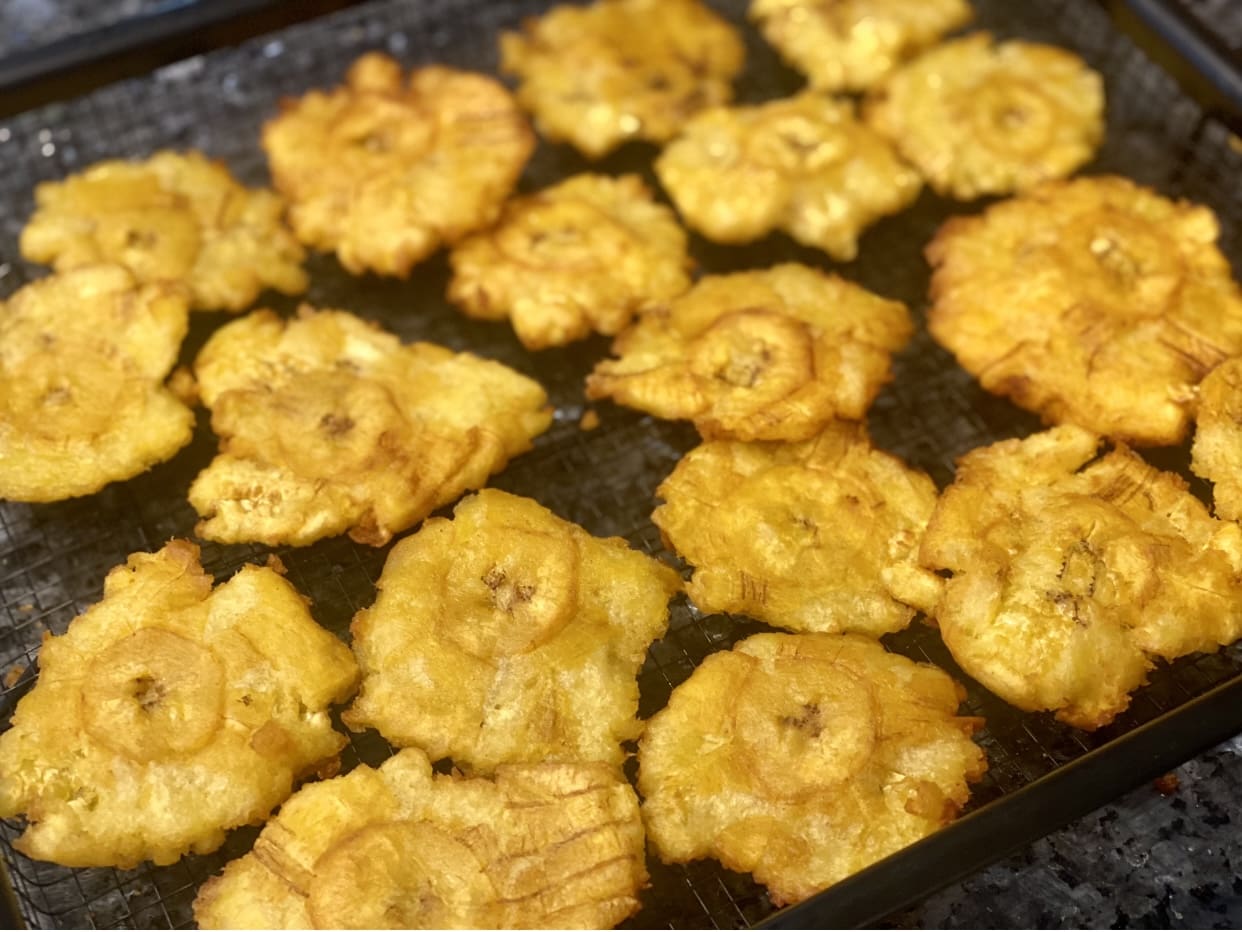
Once the plantain is cool enough to touch, use an object with a flat bottom (mug or cup) to flatten each piece of plantain. The flatter it is, the more crispy it will be. However, if it’s too thin, it may break. Use a flat spatula to remove the plantain if it’s stuck to the mug.
Working in small batches, place the flattened plantain back into the oil. To ensure even colouring, carefully flip the plantains a few times when frying. Place the plantains on a cooling rack for 2 to 3 on one level (don’t stack them) so they’ll be less greasy. Place grease-proof paper underneath the cooling rack to catch any excess oil.
Leftovers – Tostones are best served immediately to enjoy the crispy texture. To store, allow the tostones to cool completely at room temperature, then transfer into a sealed container. Store in the fridge for up to 3 days.
I’ve used a third-party application to calculate the calories and nutritional information, so please use this as an approximate guide only.
Cooking measurements are in Australian standard spoon and cup measurements. For specific details, visit our Australian Cooking Measurements page.
If you have made this recipe, I would love your feedback and support. To do this, please rate this recipe and provide a comment by scrolling down this page or by clicking that green circle on the bottom left. An email address is required (for spam), but it won’t be published. I would also love to see your dish, so don’t forget to tag me on my Instagram account ‘3catsfoodie’
Cheers – Cat T
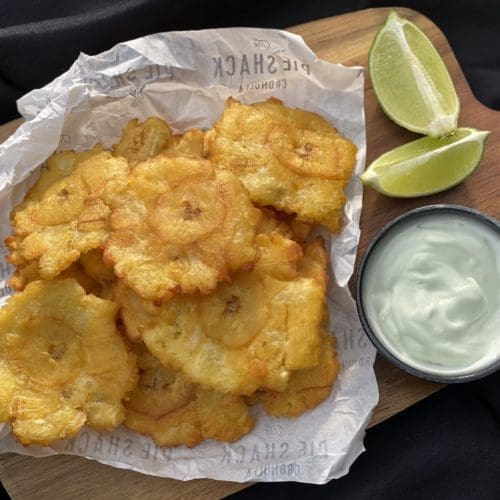
Tostones (fried plantains)
Ingredients
- 2 large green plantains (cooking bananas, sliced into 1 inch pieces) (NOTE 1)
- 4 cups cold water
- 1 tbsp salt (NOTE 2)
- vegetable oil (to fry) (NOTE 3)
Instructions
- Remove the peel by slicing a small amount from the base and top of the plantain, then use a small sharp knife to make an incision through the skin lengthwise. You should be able to pry the peel from the flesh. If the plantain is very green, you may have trouble separating the skin as I did. I had to resort to shaving the peel off by using a vegetable peeler. Cut the plantain approximately into 1-inch pieces.

- Fill a large bowl half full with water and stir in the salt until it dissolves. Place the plantains into the salted water for at least 30 minutes or up to 2 hours at room temperature.

- Pour enough oil into a medium heavy-based saucepan to submerge the plantains. Heat the oil over medium-high heat until it reaches 180°C (360°F). You could also test if the oil is ready by placing a wooden object into the oil (chopstick, skewer or wooden spoon). The oil is ready for frying when bubbles form around the object. Whilst the oil is heating, remove the plantains from the salted water and dry each piece with paper towels. This part is important because the oil will dangerously spit if there's any water left on the plantains.

- Fry the plantain in small batches for 3 minutes. You may need to adjust the heat if the oil gets too hot or drops in temperature. Remove plantains from the oil and transfer them onto a plate to cool for 5 minutes. Leave the oil heated, as we will need it for our second fry.

- Once the plantain is cool enough to touch, use an object with a flat bottom (mug or cup) to flatten each piece of plantain. The flatter it is, the more crispy it will be. However, if it's too thin, it may break. Use a flat spatula to remove the plantain if it's stuck to the mug.

- Working in small batches, place the flattened plantain back into the oil. To ensure even colouring, carefully flip the plantains a few times when frying. Place the plantains on a cooling rack for 2 to 3 on one level (don't stack them) so they'll be less greasy. Place grease-proof paper underneath the cooling rack to catch any excess oil.



